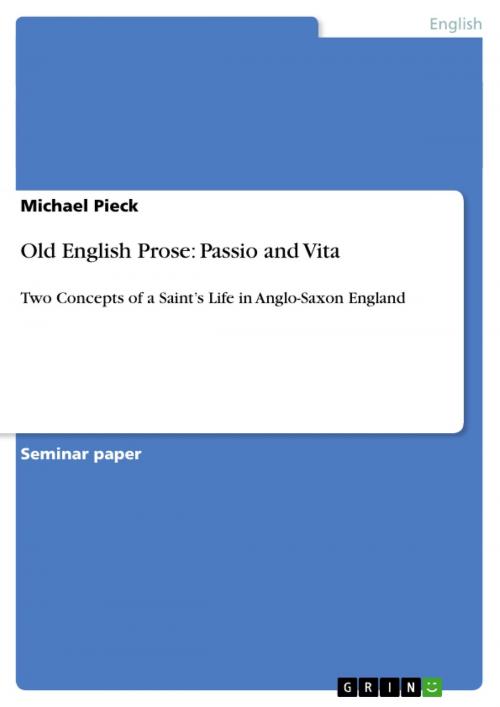Old English Prose: Passio and Vita
Two Concepts of a Saint's Life in Anglo-Saxon England
Fiction & Literature, Literary Theory & Criticism, British| Author: | Michael Pieck | ISBN: | 9783640625987 |
| Publisher: | GRIN Publishing | Publication: | May 19, 2010 |
| Imprint: | GRIN Publishing | Language: | English |
| Author: | Michael Pieck |
| ISBN: | 9783640625987 |
| Publisher: | GRIN Publishing |
| Publication: | May 19, 2010 |
| Imprint: | GRIN Publishing |
| Language: | English |
Seminar paper from the year 2009 in the subject English Language and Literature Studies - Literature, grade: 1,3, University of Cologne (Englisches Seminar), course: Hauptseminar Old English Prose, language: English, abstract: Lives of saints were a very popular genre in Christian Europe throughout the entire Middle Ages, and their popularity did not cease until the Reformation in the 16th century. Since Late Antiquity two basic concepts of saints' lives had evolved, the passio ('passion') and the vita ('life'). 'The passio was the literary form appropriate for a saint who had been martyred for his/her faith, whereas the vita properly pertained to a confessor (that is, a saint whose impeccable service to God constituted a metaphorical, not real, martyrdom).' (Lapidge 1991: 252) Saints' lives circulated widely in Anglo-Saxon England, most of which were composed in Latin. At the end of the 10th century the monk and author Ælfric of Eynsham translated a collection of forty lives of saints into the Old English vernacular. Together with his Catholic Homilies, they represent the heyday of Old English prose in the late 10th and early 11th century. The overall intention of his Lives of Saints is the same, namely to commemorate a saint on his or her feast day, and to instruct and edify the reader or hearer. The particular lives, however, are treated individually according to the different concepts, the passio and the vita. Two of Ælfric's Lives of Saints, St Edmund's and St Ætheldryth's, represent these two concepts. The former describes a man's life of active participation with a Christian impetus culminating in martyrdom and death, whereas the latter represents a woman's life remote from worldly affairs, which can also be described as a passive life. Ælfric was not just a learned monk and translator but a formidable writer and stylist in his mother tongue. The fact that he had written a book for teaching Latin in Old English leads to the assumption that he must have been familiar with the peculiarities of grammatical constructions in both languages. A comparison between The Life of St Edmund (passio) and the Life of St Æthelthryth (vita), will show that--despite many parallels--he strengthens the individual concepts, male and active vs. female and passive, not only by purely stylistic but also grammatical means.
Seminar paper from the year 2009 in the subject English Language and Literature Studies - Literature, grade: 1,3, University of Cologne (Englisches Seminar), course: Hauptseminar Old English Prose, language: English, abstract: Lives of saints were a very popular genre in Christian Europe throughout the entire Middle Ages, and their popularity did not cease until the Reformation in the 16th century. Since Late Antiquity two basic concepts of saints' lives had evolved, the passio ('passion') and the vita ('life'). 'The passio was the literary form appropriate for a saint who had been martyred for his/her faith, whereas the vita properly pertained to a confessor (that is, a saint whose impeccable service to God constituted a metaphorical, not real, martyrdom).' (Lapidge 1991: 252) Saints' lives circulated widely in Anglo-Saxon England, most of which were composed in Latin. At the end of the 10th century the monk and author Ælfric of Eynsham translated a collection of forty lives of saints into the Old English vernacular. Together with his Catholic Homilies, they represent the heyday of Old English prose in the late 10th and early 11th century. The overall intention of his Lives of Saints is the same, namely to commemorate a saint on his or her feast day, and to instruct and edify the reader or hearer. The particular lives, however, are treated individually according to the different concepts, the passio and the vita. Two of Ælfric's Lives of Saints, St Edmund's and St Ætheldryth's, represent these two concepts. The former describes a man's life of active participation with a Christian impetus culminating in martyrdom and death, whereas the latter represents a woman's life remote from worldly affairs, which can also be described as a passive life. Ælfric was not just a learned monk and translator but a formidable writer and stylist in his mother tongue. The fact that he had written a book for teaching Latin in Old English leads to the assumption that he must have been familiar with the peculiarities of grammatical constructions in both languages. A comparison between The Life of St Edmund (passio) and the Life of St Æthelthryth (vita), will show that--despite many parallels--he strengthens the individual concepts, male and active vs. female and passive, not only by purely stylistic but also grammatical means.















